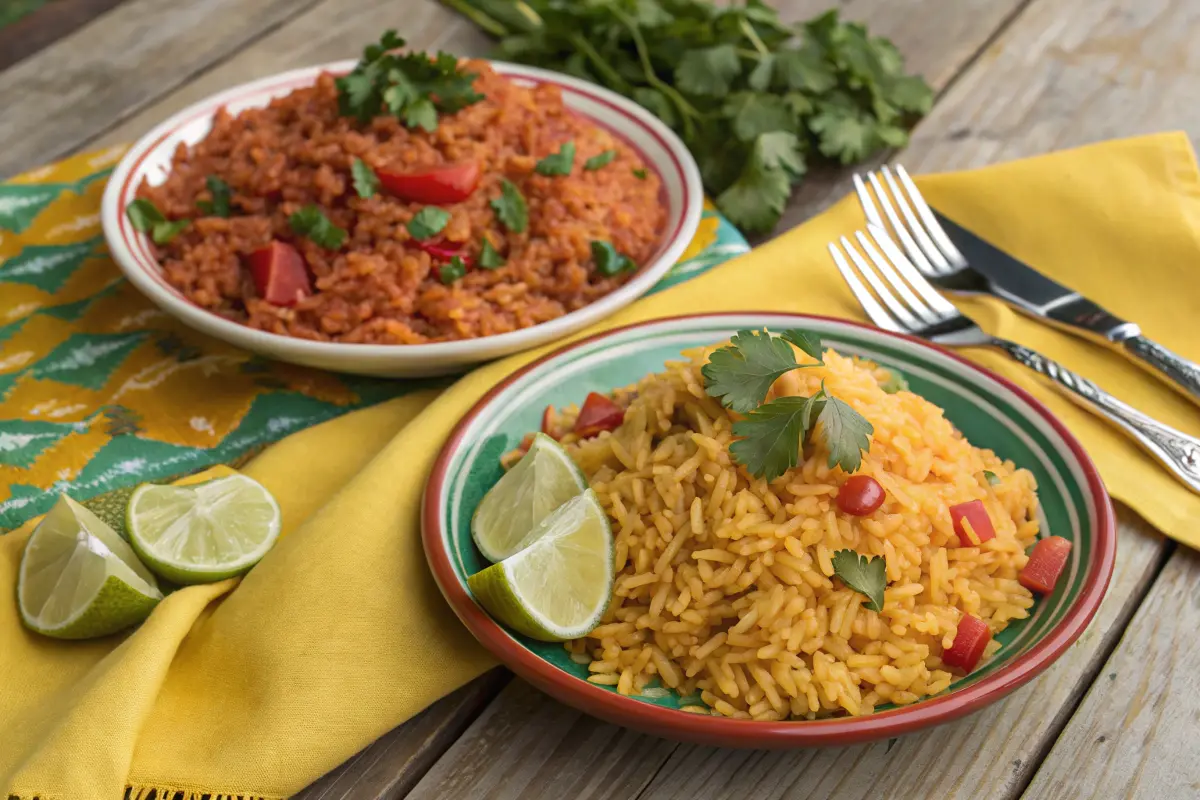Introduction
Mexican rice and Spanish rice are two flavorful side dishes that often confuse people due to their similar appearance and shared name. However, their origins, ingredients, and cooking styles are completely different. By understanding the difference between Mexican rice and Spanish rice, you can better appreciate their unique qualities and choose the one that suits your taste.
Table of contents
- Introduction
- Cultural Significance of Mexican and Spanish Rice
- Key Characteristics of Mexican and Spanish Rice
- Ingredients That Define Mexican and Spanish Rice
- Flavor Profiles of Mexican Rice vs. Spanish Rice
- Nutritional Comparison of Mexican and Spanish Rice
- Best Dishes to Pair with Mexican and Spanish Rice
- FAQs About Mexican and Spanish Rice
- Conclusion: Appreciating the Unique Qualities of Mexican Rice and Spanish Rice
- Discover More About Rice and Cooking Techniques
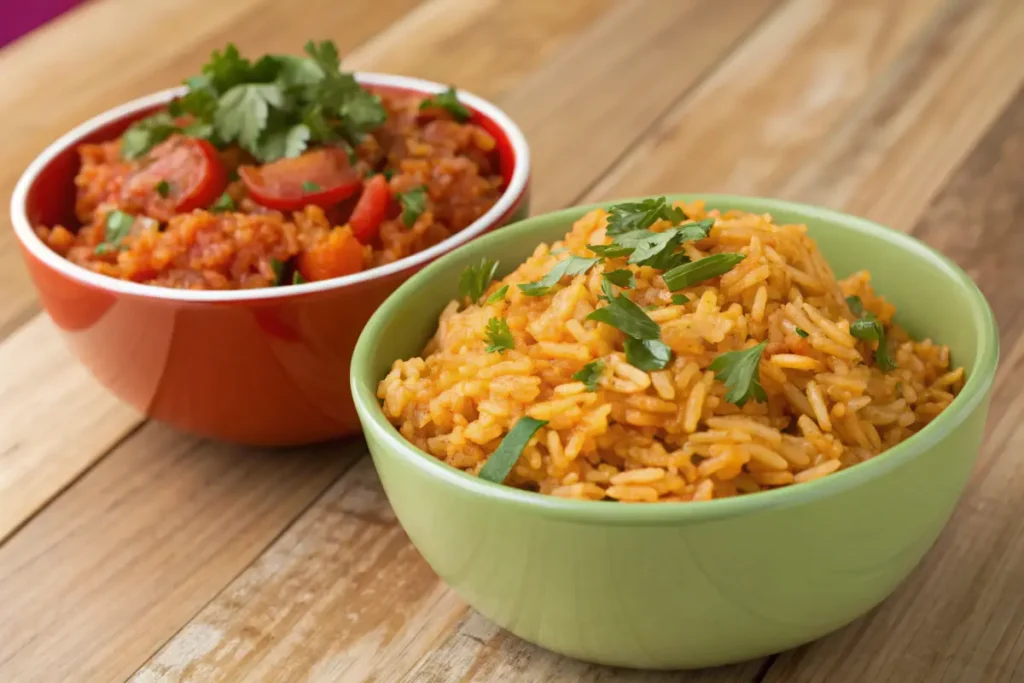
Why Compare Mexican Rice and Spanish Rice?
Mexican rice and Spanish rice both play an important role in their respective cuisines, but they have distinct characteristics. Mexican rice, with its mild spices and tomato-based flavor, complements dishes like enchiladas and tacos. On the other hand, Spanish rice reflects the Mediterranean flavors of Spain, featuring saffron and olive oil as signature ingredients. By comparing the two, we gain insight into how regional ingredients and traditions influence cooking styles.
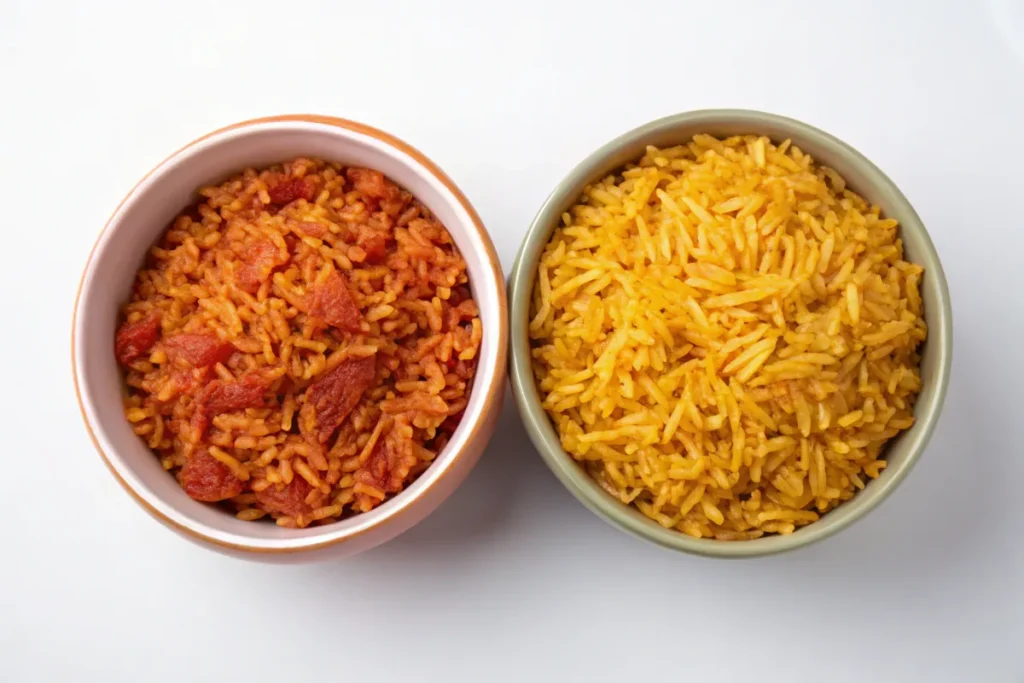
Cultural Significance of Mexican and Spanish Rice
Mexican Rice: A Traditional Favorite
Mexican rice, often called “arroz rojo,” has been a staple in Mexican cuisine for generations. Families serve it alongside beans, tacos, and other popular dishes. Its vibrant red color and slightly spicy flavor make it a comforting addition to meals. Many households cook it frequently, adding their own twists to the recipe.
Spanish Rice: A Reflection of Mediterranean Heritage
Spanish rice is a cornerstone of Spain’s culinary traditions. Unlike Mexican rice, Spanish rice features a golden-yellow hue, which comes from saffron or turmeric. This dish pairs well with seafood, meat, or vegetables and often appears in celebratory dishes like paella. Its rich, aromatic flavors reflect Spain’s Mediterranean heritage.
Key Characteristics of Mexican and Spanish Rice
Defining Features of Mexican Rice
Mexican rice is light, fluffy, and seasoned with ingredients like tomatoes, garlic, onion, and cumin. Its tomato base gives it a vibrant orange or red hue. Chefs typically sauté the rice before simmering it in broth, which ensures every grain absorbs maximum flavor. Additionally, it often includes vegetables such as peas, carrots, or corn for extra texture.
Unique Qualities of Spanish Rice
Spanish rice, in contrast, has a rich and creamy texture. Saffron, one of its signature ingredients, gives it a distinct golden color and a bold, earthy aroma. Olive oil adds richness, while garlic, onion, and tomatoes enhance its depth. Spanish rice is more robust in flavor compared to Mexican rice, making it a perfect match for hearty Mediterranean dishes.
Ingredients That Define Mexican and Spanish Rice
Understanding the key ingredients of Mexican rice and Spanish rice reveals much about their unique flavors and preparation styles. While both dishes use rice as their base, their seasoning and additional components create entirely different results.
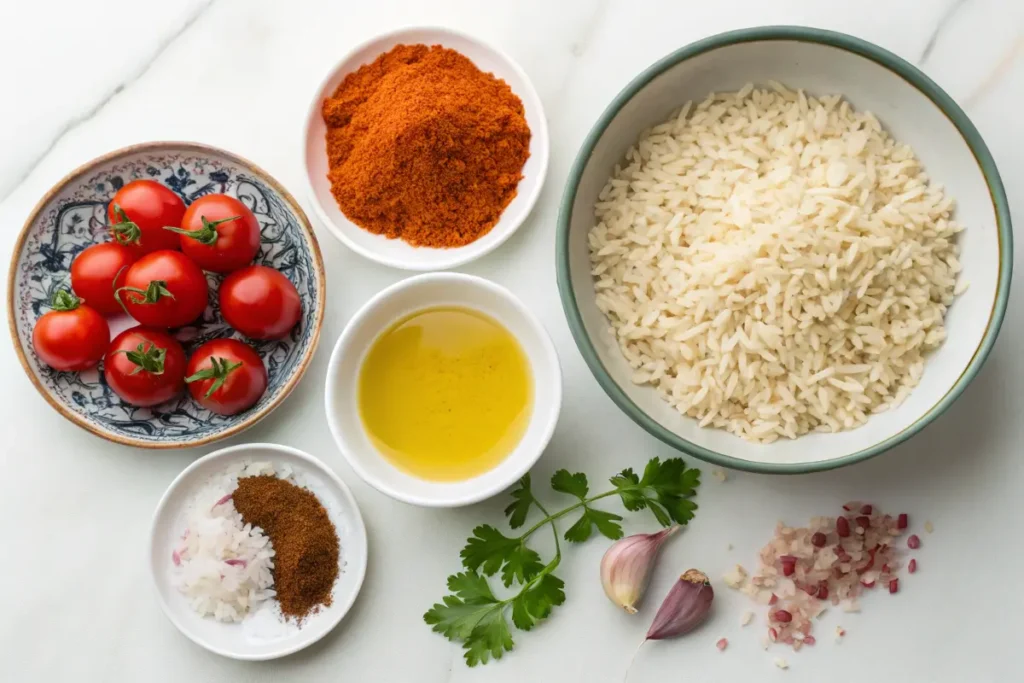
Essential Ingredients
Mexican rice, also known as “arroz rojo,” is made using a short- or medium-grain rice. Tomatoes, tomato paste, or blended fresh tomatoes form the foundation of its flavor. Garlic, onion, and cumin are added to enhance the dish’s depth.
In many recipes, chicken broth replaces water for cooking, making the rice more flavorful. Vegetables like peas, carrots, or corn are also common additions. For extra spice, some people include jalapeños or serrano peppers, but the dish is not typically considered overly spicy. The combination of these ingredients gives Mexican rice its bright red hue and slightly tangy taste.
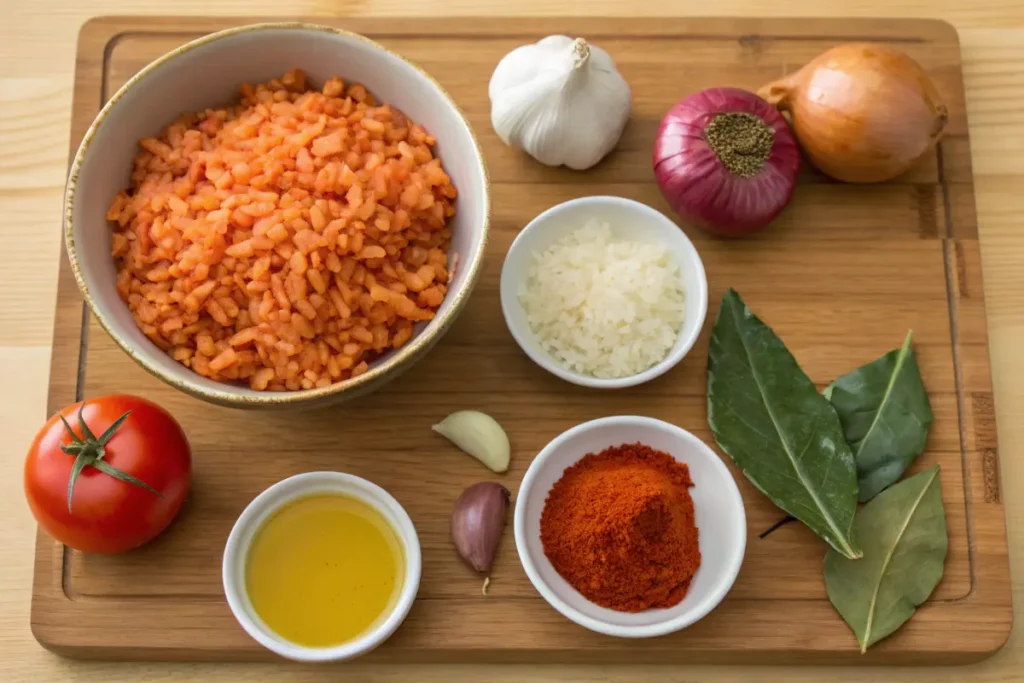
Signature Ingredients in Spanish Rice
Spanish rice takes a different approach to its seasoning and ingredients. Its golden-yellow color comes from saffron, which is prized for its rich flavor and aroma. If saffron is unavailable, turmeric is sometimes used as a substitute. The dish also incorporates olive oil, which creates a rich texture and enhances the Mediterranean flavor profile.
Like Mexican rice, Spanish rice features garlic, onion, and tomatoes, but it often omits additional vegetables. The focus remains on the rice’s creamy consistency and its ability to soak up flavors. Some versions of Spanish rice include stock made from seafood or chicken, depending on the dish it’s served with.
Cooking Techniques That Set Them Apart
How these two dishes are prepared further differentiates them. While the ingredients lay the foundation, the cooking methods are equally important in creating their signature textures and flavors.
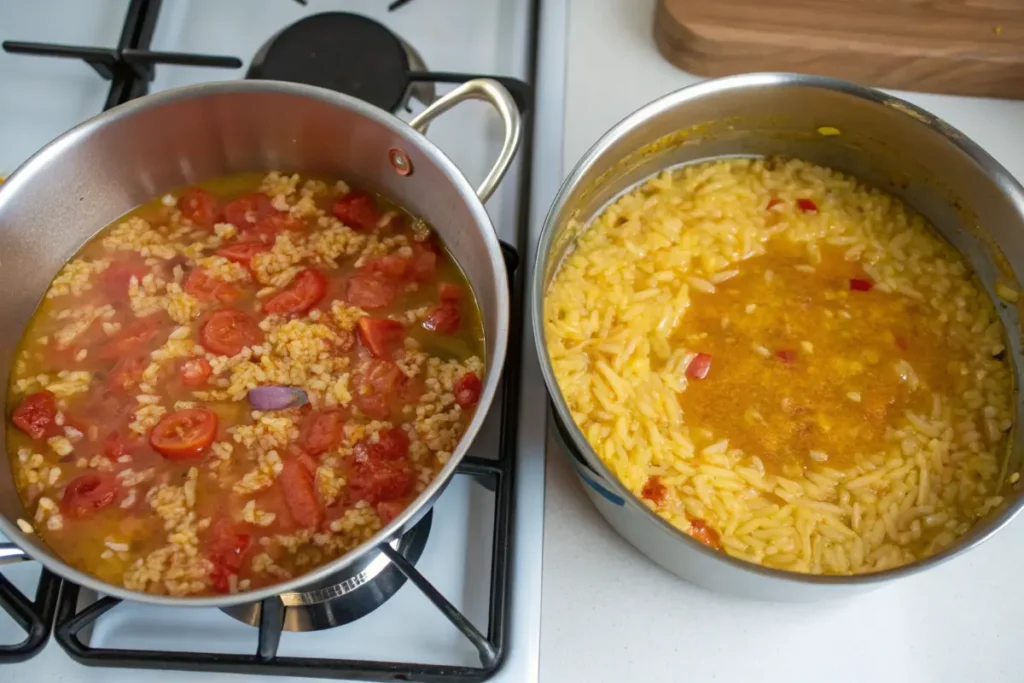
How Mexican Rice Is Traditionally Prepared
To prepare Mexican rice, the rice is typically sautéed in oil until it becomes lightly golden. This step enhances the rice’s flavor and helps it remain fluffy once cooked. After toasting, blended tomatoes, onion, garlic, and spices are added to the pot. The mixture simmers in chicken broth or water until the rice absorbs all the liquid.
This method ensures that the grains remain separate and fluffy, avoiding clumps. It’s important not to overcook the rice, as that can result in a mushy texture. Mexican rice is generally cooked in one pot, making it an easy side dish for any meal.
How Spanish Rice Gets Its Distinctive Texture
Spanish rice is often baked or cooked in a paella pan, which helps create its rich, creamy consistency. Unlike Mexican rice, the preparation involves simmering the rice in saffron-infused broth. Olive oil is used to coat the rice at the beginning, creating a smooth texture.
Some recipes call for cooking the rice with seafood, chicken, or chorizo, which adds depth and protein to the dish. Spanish rice is also known for developing a slightly crispy layer at the bottom of the pan, often considered a delicacy in paella. The technique ensures that the rice absorbs maximum flavor while achieving a perfect texture.
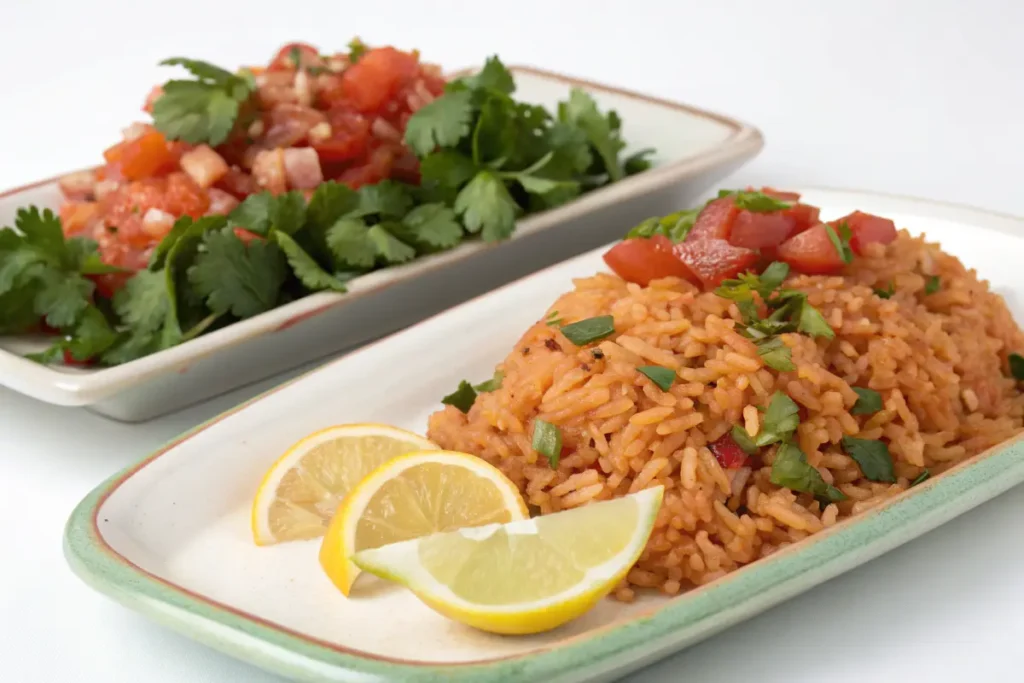
Flavor Profiles of Mexican Rice vs. Spanish Rice
The flavor profiles of Mexican rice and Spanish rice highlight the culinary traditions of their respective origins. Each dish brings unique tastes and aromas that make them versatile and delicious.
The Mild, Earthy Taste of Mexican Rice
Mexican rice delivers a mild and savory flavor that complements many traditional dishes. Tomatoes create a tangy base, while spices like cumin and garlic add depth and earthiness. Chefs often cook the rice in chicken broth, which enhances its savory qualities and makes it more flavorful. For an extra layer of heat, some cooks add diced jalapeños or serrano peppers.
This dish shines for its balance. Its light and fluffy texture pairs perfectly with bold dishes like enchiladas, tacos, or grilled meat. Mexican rice doesn’t overpower the main course, making it an ideal accompaniment to spicy or heavily seasoned meals.
The Rich, Aromatic Flavor of Spanish Rice
Spanish rice, on the other hand, offers a bolder and more aromatic flavor. Saffron, one of the dish’s defining ingredients, adds a floral aroma and a slightly sweet, earthy taste. Olive oil enhances its richness, while garlic, onion, and tomatoes bring additional depth. Unlike Mexican rice, Spanish rice often features a creamy texture that comes from simmering it in broth.
The golden hue of Spanish rice, often achieved with saffron or turmeric, makes it visually appealing and enhances its Mediterranean vibe. It pairs exceptionally well with seafood, roasted vegetables, or dishes inspired by Spanish cuisine. Many diners also enjoy the crispy “socarrat” layer at the bottom of the pan, which adds an exciting contrast in texture.
Nutritional Comparison of Mexican and Spanish Rice
The nutritional differences between Mexican rice and Spanish rice stem from their distinct ingredients and cooking techniques. Knowing their nutritional profiles can help you select the one that best suits your diet and preferences.
Calories and Macronutrient Differences
Mexican rice tends to have fewer calories than Spanish rice. Most recipes use less oil, resulting in a lighter dish with approximately 200 calories per serving. The carbohydrates in Mexican rice provide energy, while the vegetables, such as peas or carrots, add fiber and vitamins.
In contrast, Spanish rice contains more calories because chefs use olive oil and sometimes include proteins like chorizo or seafood. A serving typically ranges between 250 and 300 calories, depending on the recipe. While Spanish rice has more fat, it primarily comes from healthy fats in olive oil, which offer heart-health benefits.
Adjusting Recipes for Dietary Needs
Both dishes can easily adapt to different dietary preferences. For a low-carb version of Mexican rice, cooks can use cauliflower rice as a substitute. Similarly, Spanish rice can become lighter by reducing olive oil or skipping the proteins. Both options are naturally gluten-free, making them great for individuals with gluten sensitivities or those following a gluten-free diet.
Best Dishes to Pair with Mexican and Spanish Rice
Both Mexican rice and Spanish rice shine as side dishes, but their distinct flavors and textures make them suitable for pairing with different types of meals. Here, we’ll explore some of the best dishes to serve alongside each rice variety.
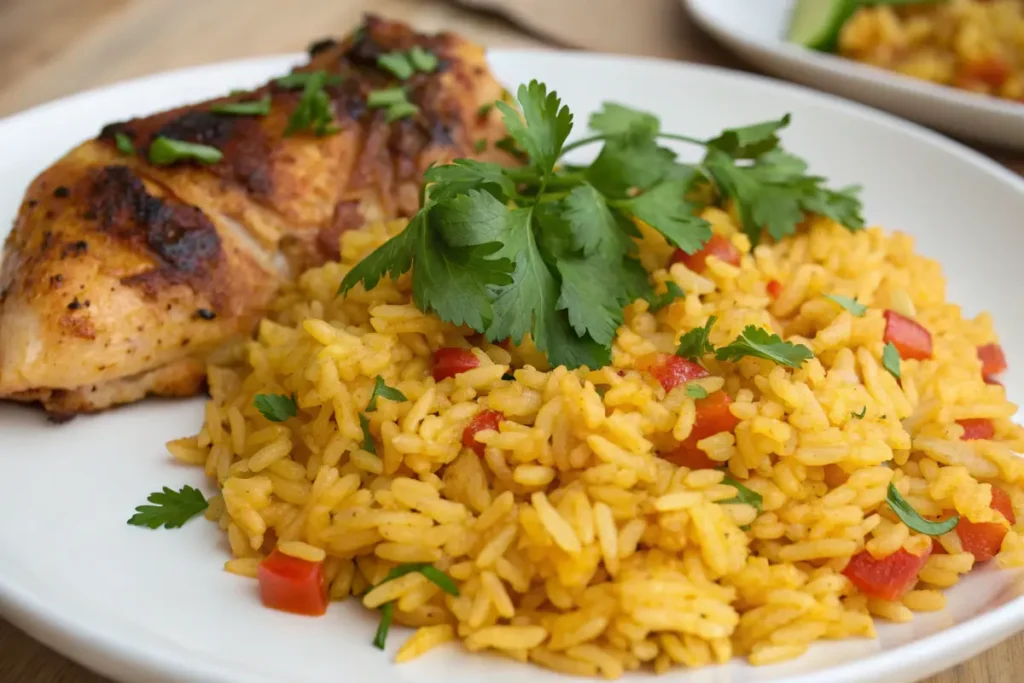
Traditional Pairings for Mexican Rice
Mexican rice is a staple in Mexican cuisine, often served with bold, spicy, and hearty dishes. It complements the flavors of many traditional meals without overwhelming the palate. Here are a few popular pairings:
- Enchiladas: The mild, earthy flavor of Mexican rice balances the richness of cheese or meat-filled enchiladas.
- Tacos: Served on the side, it adds texture and flavor to taco platters featuring beef, chicken, or vegetarian fillings.
- Grilled Meats: Mexican rice pairs wonderfully with carne asada (grilled steak), pollo asado (grilled chicken), or al pastor (marinated pork).
- Refried Beans: Together with refried beans, Mexican rice creates a hearty, comforting combination.
- Chiles Rellenos: The mild spiciness of Mexican rice complements the bold, cheesy flavors of stuffed poblano peppers.
Additionally, you can serve Mexican rice as a base for burrito bowls or simply enjoy it on its own as a light lunch.
Perfect Pairings for Spanish Rice
Spanish rice’s rich, aromatic flavor makes it a great match for Mediterranean and Spanish-inspired dishes. Here are some ideal pairings:
- Paella: Spanish rice is often used as the base for paella, where it soaks up the flavors of seafood, chicken, or chorizo.
- Grilled Seafood: The creamy texture and saffron-infused flavor of Spanish rice pair beautifully with grilled shrimp, scallops, or fish.
- Roast Chicken: Spanish-style roast chicken with garlic and herbs complements the bold taste of Spanish rice.
- Vegetable Dishes: Grilled or roasted vegetables, such as eggplant, zucchini, or bell peppers, pair well with Spanish rice.
- Tapas: Serve Spanish rice alongside tapas like patatas bravas, manchego cheese, or stuffed olives for a Mediterranean feast.
Spanish rice also works as a standalone dish, particularly when prepared with proteins like chicken or seafood for added heartiness.
FAQs About Mexican and Spanish Rice
The main difference lies in their flavor, color, and ingredients. Mexican rice has a tomato-based flavor with mild spices, while Spanish rice features saffron, giving it a rich aroma and golden color. Additionally, Mexican rice has a fluffy texture, whereas Spanish rice is often creamier.
Both dishes can be healthy, but Mexican rice is typically lighter because it uses less oil. On the other hand, Spanish rice often includes olive oil and proteins like chorizo or seafood, which add calories but also provide healthy fats and nutrients. The healthier option depends on your dietary preferences.
Yes, you can use Spanish rice in Mexican dishes, but the flavors might not align perfectly. For example, the floral aroma of saffron in Spanish rice may not complement the bold, spicy flavors of Mexican food as well as Mexican rice does. However, if you’re experimenting, it can still be an enjoyable variation.
Mexican rice can sometimes include jalapeños or serrano peppers, making it mildly spicy, but this depends on the recipe. Spanish rice, however, rarely includes spicy ingredients. As a result, Mexican rice tends to have more of a kick, but it’s not overwhelmingly hot.
Yes, you can easily make Mexican rice vegan by substituting chicken broth with vegetable broth. Additionally, ensure that no animal-based fats, such as lard, are used during the cooking process. This simple substitution retains the flavor while making the dish plant-based.
Conclusion: Appreciating the Unique Qualities of Mexican Rice and Spanish Rice
Mexican rice and Spanish rice are two delicious dishes with unique characteristics, flavors, and cultural significance. While they both use rice as a base, their differences in ingredients, preparation, and flavor profiles make them distinct. Mexican rice offers a mild, tomato-based flavor with a fluffy texture, making it the perfect side dish for spicy and hearty Mexican meals. On the other hand, Spanish rice is rich and aromatic, with saffron providing its signature golden hue and a creamy texture ideal for Mediterranean dishes.
By understanding the difference between Mexican rice and Spanish rice, you can better appreciate how these dishes reflect their respective culinary traditions. Whether you’re preparing a traditional Mexican feast or a Spanish-inspired dinner, each dish brings something special to the table.
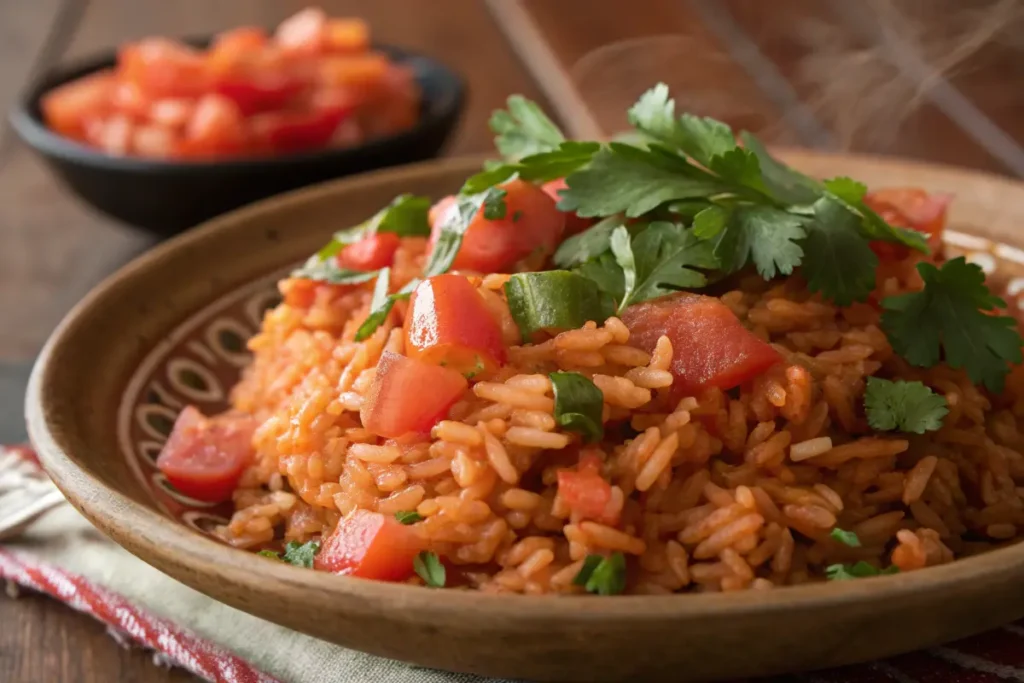
Discover More About Rice and Cooking Techniques
If you’re eager to expand your knowledge about rice and how to incorporate it into your cooking, explore the following resources:
- For an authentic Spanish rice recipe and step-by-step instructions, check out Spanish Rice Recipe.
- Wondering whether you should cook rice before adding it to a casserole? Learn more in this helpful guide: Do You Cook Rice Before Putting It in a Casserole?.
- If you’re curious about the health benefits of pairing rice with chicken and broccoli, read Is Eating Rice, Chicken, and Broccoli Healthy?.
- For a fun comparison between rice pudding and cream of rice, don’t miss this article: Rice Pudding vs. Cream of Rice: Key Differences.

